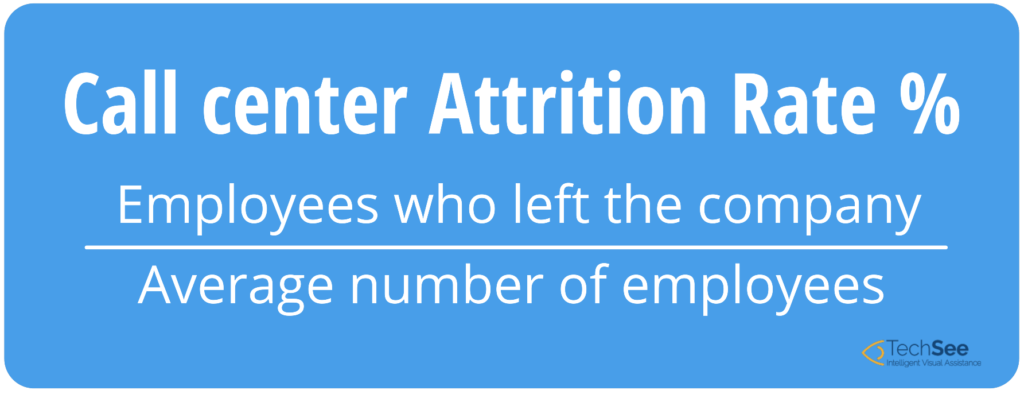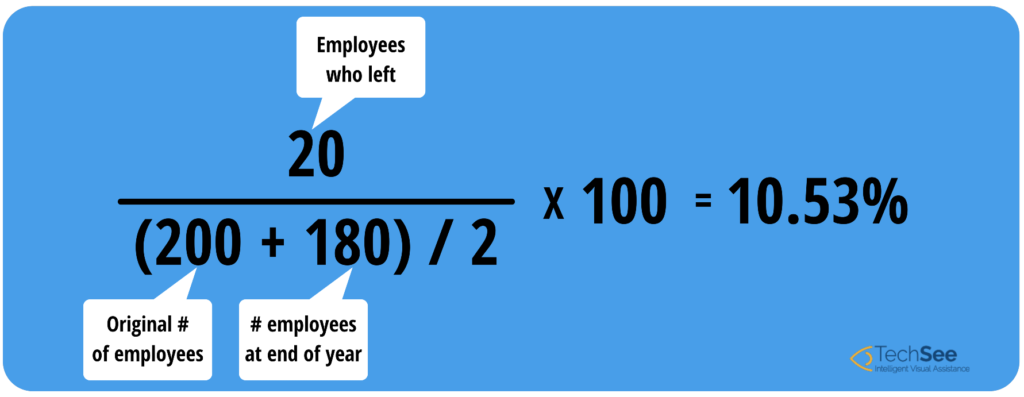Contents
- What Is Call Center Attrition Rate?
- How Do We Calculate Call Center Attrition Rate?
- Call Center Attrition Benchmarks
- What Is the Industry Standard of Call Center Attrition Rate?
- Call Center Turnover Statistics 2021
- Call Center Employee Turnover: Outlook for 2022
- Understanding the Cost of Call Center Attrition
- 6 Ways To Bring Down Call Center Employee Turnover Rates
- Next Steps to Managing Call Center Attrition
Unprecedented levels of turnover are a sign of the times, and organizations are paying the price. Employees are leaving for various personal and professional reasons, and each industry faces unique circumstances and varied attrition rates. But no matter the “why,” the bottom line is the same – addressing the pain point of employee turnover presents a challenge.
Call centers are no exception to the difficulties of managing employee turnover and its impact on operations and customer experience. Staffing shortages, the challenges of maintaining work-life balance in remote work, and other disruptions caused by the COVID-19 pandemic have made a tough job even tougher. Rising call volumes and demands, not to mention the need for patience and empathy to deal with frustrated customers, have led to increased agent burnout, driving people to search for new jobs.
What Is Call Center Attrition Rate?
Call center attrition is when an agent leaves the company, whether voluntarily or non voluntarily, and the company does not hire a replacement. Attrition rate is a metric used to determine the percentage of agents out of the total workforce that leave the organization each year.
Similar to attrition, turnover refers to when a call center agent leaves, but the company hires a new agent. Reducing the high rate of attrition and turnover in general are key challenges of call center managers in all industries, especially since there is no one single cause.
How Do We Calculate Call Center Attrition Rate?
Here’s a simple formula to calculate your call center attrition rate:

Call center attrition rate is a percentage which expresses the number of employees who left the company divided by the average number of company employees. For example, if at the start of 2021 you had 200 agents and 20 people left, you ended the year with 180 employees. The average number of employees in your company is the total number at the beginning of the year plus the total number at the end of the year, divided by two. This is the equation to calculate the annual attrition rate:

Call Center Attrition Benchmarks
While employee turnover is at an all-time high in virtually all professions, the average turnover rate for call centers is downright dismal. In fact, according to Contact Babel, agent attrition rates have been on the rise since 2013, when the mean agent attrition rate had been steady for three years at 27%. It then rose to 29% in 2015 and 2016, and was reported at 34% in 2019. There was a slight decrease in call center attrition in 2020, as fewer companies have been hiring new employees due to the COVID-19 pandemic.
| Year-end | Mean annual agent attrition rate | Median annual agent attrition rate |
|---|---|---|
| Call center turnover rates 2013 | 27% | 19% |
| Call center turnover rates 2015 | 29% | 18% |
| Call center turnover rates 2016 | 29% | 20% |
| Call center turnover rates 2017 | 30% | 20% |
| Call center turnover rates 2018 | 31% | 23% |
| Call center turnover rates 2019 | 34% | 24% |
| Call center turnover rates 2020 | 30% | 20% |
Source: ContactBabel
What Is the Industry Standard of Call Center Attrition Rate?
Historically, call center attrition rates have always been high due to the repetitive and monotonous nature of the work, the challenge of having to handle too many calls, and low employee engagement. In general, the average annual turnover rate for call centers has remained relatively stable over the past years, around 30-45 percent, above the average for all other occupations. The COVID-19 pandemic actually reduced the attrition rate in 2020, because fewer companies were hiring new employees.
Call Center Turnover Statistics 2021
2021 was not only the year of the pandemic – it was also designated as the year of the Great Resignation – with people revisiting the impact of their job on their life in various parameters, searching for better opportunities. The call center industry was no exception. A Gallup analysis in early 2021 found that almost half of the working population in the U.S. was actively looking for a job – and that included about one-third of the call center agents.
According to a 2021 study by Calabrio, the primary reason for call center employee turnover was attributed to high stress levels, with 96% feeling acute stress at least once a week, having to deal with an exceptionally high volume of complex customer calls, compounded by pandemic-driven workforce shortages.
Call Center Employee Turnover: Outlook for 2022
The high call center attrition rate is not just a trend – economists expect that high turnover will continue in 2022. However, it can be properly addressed with an employee-centric approach, tackling agent concerns by providing the technology to help agents deal with stress and succeed in their jobs, offering work flexibility and investing in employee development.
Shifts in employee expectations and preferences have led to a higher percentage of active job seekers. Beyond compensation, the option of hybrid work models and flexible hours are also an increasingly important factor for workers. Organizations also anticipate an increased turnover rate, both voluntary and involuntary, in response to vaccine mandates.
Understanding the Cost of Call Center Attrition
The cost of call center attrition is more than just a salary – you’re replacing an experienced worker, which takes time and investment while facing the challenge of maintaining customer satisfaction. You have to consider the costs of onboarding, training, and the time it takes for a new employee to get fully into the swing of things – which is about eight months.
Replacing workers requires one-half to two times the employee’s annual salary – which can reach astronomical costs. And if that’s not enough to throw a wrench into smooth operations and your budget – statistics show that about one third of new employees look for a new job within the first six months. Employee turnover also impacts key performance metrics, with fewer resources potentially leading to lower quality of service.
So what’s the best way to retain agents and reduce the cost of call center attrition? There are a few important steps that management can take.
6 Ways To Bring Down Call Center Employee Turnover Rates
Here are some ways to help keep call center turnover rates down while enhancing operations.
Automation
Simplify and automate processes and provide real-time decision-making support for agents to troubleshoot and resolve issues. Automation can help agents handle repetitive tasks and save them from having to answer the same questions over and over. Agents can focus on more productive live calls, improving employee engagement and satisfaction.
Employee Onboarding and Training
Empower agents with the training and resources to help customers, enhancing motivation and improving quality of service. This includes soft skills coaching, such as how to speak with customers and address their requests, as well as technology training.
Maximize Employee Retention/Satisfaction
Employee experience is on par with customer experience as a top call center KPI. Improve employee retention with tools to help agents succeed, provide work flexibility and development opportunities.
Utilize AI-Powered Technology to Maintain Volume
Leverage technology to help handle increased customer demand, enable intelligent routing and shorten call time, reducing the burden on agents and improving workflow.
Optimize problem resolution
Provide agents with first-rate tools and AI-driven solutions to increase first call resolution and provide better service, such as visual support and seamless transition between multiple communication channels, to increase agents’ pride in their work and successful customer interactions.
Maximize Net Promoter Score (NPS)
NPS is a metric used to measure customer experience. The ability to address customer issues quickly and accurately improves both customer and agent engagement. Incorporating new technologies to eliminate the need for the traditional long Q&A with agents, streamlining operations and improving agent problem-solving ability, will have a positive impact on NPS and agent motivation.
Next Steps to Managing Call Center Attrition
Managing call center attrition is a challenge; however, if you take steps to empower and motivate your agents and leverage technology to optimize engagement, you’ll be well positioned to maintain a stable, and satisfied, workforce. Now more than ever, as the customer service landscape is changing, it’s important to embrace change and stay ahead of the curve, augmenting both customer and employee experience while increasing call center efficiency and success rates.







